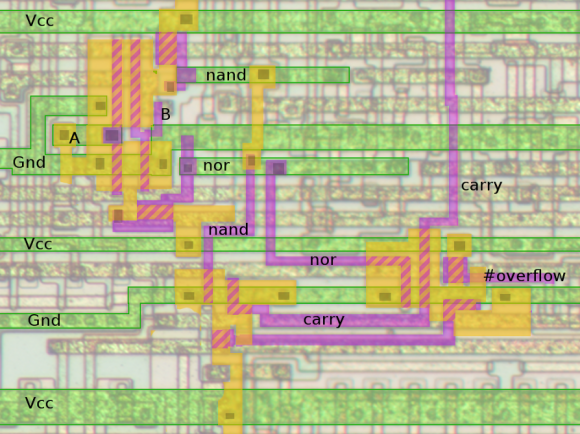Results 1 to 1 of 1
Thread: How 6502 Overflow Works
-
January 15th, 2013, 22:48 #1Won Hung Lo













- Join Date
- Apr 2003
- Location
- Nottingham, England
- Age
- 54
- Posts
- 141,746
- Blog Entries
- 3209
- Rep Power
- 50
 How 6502 Overflow Works
How 6502 Overflow Works

The 6502 was a ubiquitous microprocessor back in the 80s, powering devices such as the Apple II and the Nintendo Entertainment System. [Ken] took an in depth look at a small part of the processor: the overflow circuit.
In order to do signed calculations, a microprocessor’s arithmetic logic unit (ALU) needs to be able to calculate when an overflow occurs. This happens when two numbers are added that cannot fit in a single byte. The result of a calculation will be incorrect, so the processor must inform the program that an overflow has occurred. This is done by setting an overflow flag.
[Ken] uses this example to first explain how the overflow circuit works in logic. He then looks at the gates and a transistor implementation of the logic. Finally, he walks us through the circuit on the actual 6502 die, showing how the circuit is constructed in silicon.
This is a great example to learn a bit more about how ALUs work and how integrated circuits get built.
http://hackaday.com/2013/01/15/how-6502-overflow-works/
Thread Information
Users Browsing this Thread
There are currently 1 users browsing this thread. (0 members and 1 guests)
Similar Threads
-
Need help getting any emulators working
By DCVPBC in forum DCEmu Gaming & General Discussion ForumReplies: 21Last Post: February 11th, 2005, 14:46 -
How to get .fds working in NesterDC
By FamicomDS in forum DCEmu Gaming & General Discussion ForumReplies: 3Last Post: November 16th, 2004, 09:53 -
Nesterdc still not work
By Nork in forum DCEmu Gaming & General Discussion ForumReplies: 1Last Post: September 27th, 2004, 23:20 -
custom logo ip.bin not working
By SeAcabo in forum DCEmu Gaming & General Discussion ForumReplies: 6Last Post: September 25th, 2004, 19:11 -
Would this work on NX Doom
By wraggster in forum DCEmu Gaming & General Discussion ForumReplies: 12Last Post: June 11th, 2004, 15:40




 Reply With Quote
Reply With Quote

Bookmarks